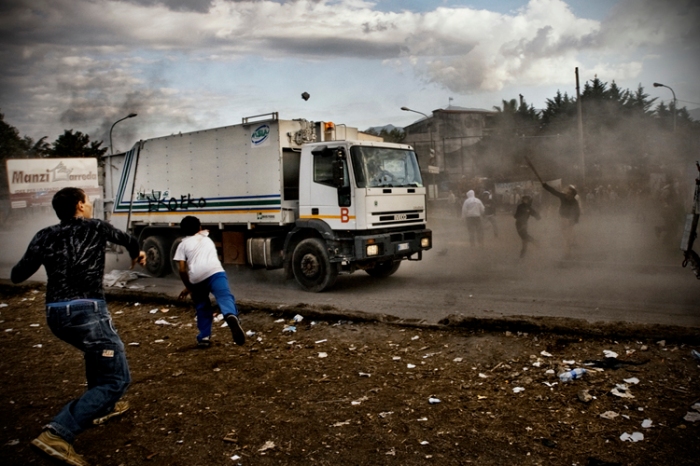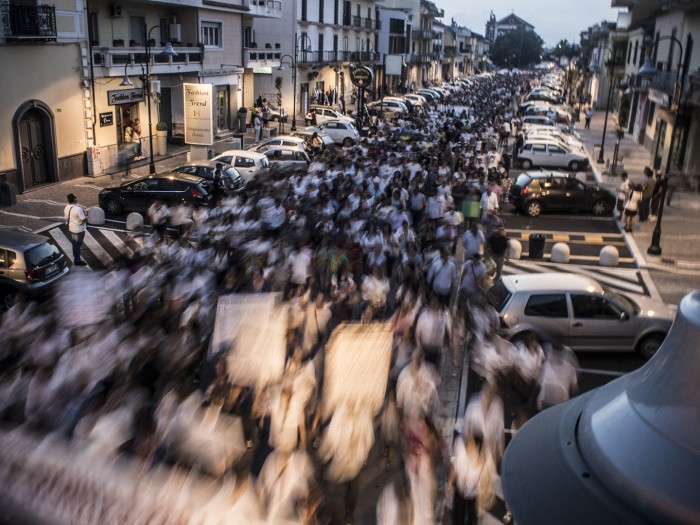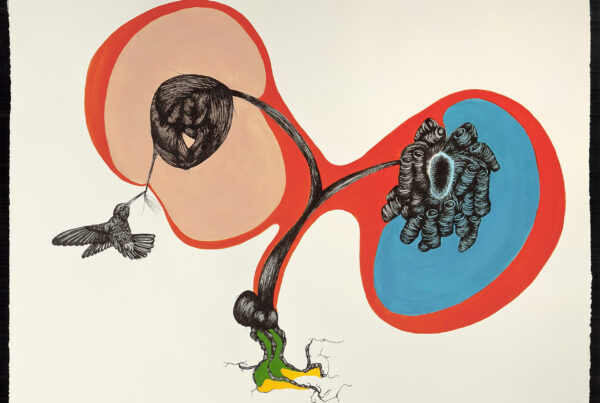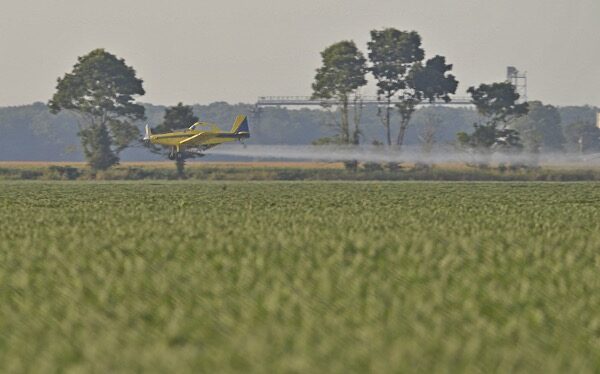Social mobilizations in Campania are changing the political, economic, cultural and ecological landscapes of the region. Their strategies and practices draw a path of resistance and reappropriation that can inspire environmental movements in Italy and elsewhere.
The 15 year-long grassroots mobilizations, which emerged in reaction to waste (mis)management and illegal disposal in the Campania region of Southern Italy, represent a useful entry point to distill important lessons for bottom-up activism. Here, I provide an overview of their path from a constellation of unrelated citizens’ committees resisting localized threats, to a regional coalition acting at several scales for implementing new models of political participation, and of territorial and community well-being.
In particular, I highlight three organizational tools that, beyond strengthening and rooting collective action, address systemic social, economic and ecological inequalities. After introducing the processes leading to livelihoods degradation in Campania, I analyse the following performances of the grassroots movements: the linking of different fronts of struggle at regional and national scales; the widening of the scope of the movements’ engagement; and the work on community’s autonomy through practices of re-appropriation, that is, the reclaiming of physical spaces and popular knowledges.
Trashing bodies and ecosystems
Over the course of the last twenty years, the provinces of Naples and Caserta, an area of Campania region of 3.800 sq. km and inhabited by approximately four million people, have been turned into a huge trashcan. The joint actions of the government-sponsored urban waste management project and of a complex network of mafia groups, industrial mangers, corrupted white collars and public officials, created a system for the extraction of profits from the disposal of waste at the expenses of local livelihoods.
On the one hand, the authoritarian governance of urban waste management for the entire region, formally framed by the government as an “emergency”, became a succulent business for private investors, who could enjoy law derogation and optimal contractual conditions for the implementation of facilities according to a project centered on incinerators, landfills and storage sites. On the other hand, the infamous trafficking, wild dumping, open-air burning and illegal disposal of hazardous materials, mostly from industrial production, turned portions of the region into a sink of toxic scraps. Both processes shifted onto communities and ecologies the environmental costs of industrial production and waste disposal.
This translated into a potentially toxic environment for the local population, affected today by threats to health, reduction of cultivable land and stigmatization. More than 2,000 potentially contaminated sites have been recorded in 2008 by the Regional Agency for Environmental Protection, and the complex links between those contaminants and the increase in cancer diseases among the locals have been investigated by several scientific studies, sparkling controversies over the causal relationships.
Moreover, the stigmatization through media accounts of Campania’s land as hopelessly contaminated had a generalized impact on agricultural sales from the region: even when products are certified as safe, buyers of the Great Distribution avoid them, forcing many active farmlands (the traditional landmark and one of the most valuable economic sectors in Campania) to close down, thus providing further land for speculation.
The hazards to public health have been recognized by the central government through the insertion of three large areas of Campania in the national record of polluted sites in need of remediation, together with other 39 places all over Italy. Nevertheless, clean-up works are still minimal and the authoritarian governance of environmental management and land-use planning still dominates Italy’s political landscape.
Framing local threats as structural inequalities
When the “emergency regime” declared by the Italian government for the management of urban waste in Campania begun in 1994, people in the municipalities of the plains targeted by the imposed facilities reacted on a local basis. During the battle against the incinerator of Acerra in the early 2000s, for example, the local committee made up of ordinary people, farmers and students, did not receive substantial support from other municipalities or organized groups. The self-formation of the activists focused on a critique of the technology of incineration and on the contamination already present in the rural areas of the town. The battle of Acerra was lost in 2004 under the batons of hundreds of police officers sent by the government, but the state-sponsored attack on territories soon moved to other spots where landfills and storage sites were planned.
The linking of Acerra’s committee with the citizen groups emerging in Chiaiano, Pianura, Serre and Giugliano was pursued by activists through the identification of recurring patterns: the techno-managerial approach to urban trash management, the authoritarian governance model, the state facilitation of illegal toxic waste disposal, the lack of people’s involvement in decision-making processes, the dismissal of alternatives, and the risks posed to humans and environments by outdated facilities and contaminated sites.
Within a few years, by relying on extensive and transversal information campaigns, regional alliances were formed, and delegations were travelling from one place to another following the eruption of new front-lines. At the collective assemblies, through knowledge exchanges and the elaboration of a shared vision of the problem, the committees came to the conclusion that incinerators, landfills and illegal disposal were part of a wider project for the top-down implementation of an economy revolving around waste.
Between 2010 and 2013, the cooperation between local committees united into alliances produced a broader conceptualization of the enemy they were facing: Biocide. In the conception developed by activists, Biocide articulates the relationships between political-economic processes and their complex interaction with ecosystems and bodies: it connects the “killing of life” to strategies of profit-making. The notion illustrates the interdependent features of cost shifting and life-killing as a deliberate project to which a territory is sacrificed: for every contaminant released in the environment, powerful economic actors are able to displace the burden of their compliance costs onto people and ecologies.
This concept helped to frame the issue of contamination beyond the specificity of the contested process (waste) and turned out to be fundamental in order to build alliances between similar struggles and with other social movements in Italy engaged against the same, underlying, structural processes. Since then, the coalition Stop Biocide has been growing nationally, embraced by movements fighting against oil extraction, mega-infrastructure projects, polluting industries and land speculation.
Elaborating alternatives within a wider project
The contradiction faced by activists, caught between the need to focus on the specific threat suffered by their communities and the need to address the wider, structural causes of the localized problem, lies at the core of the difficult path from resisting locally to joining forces and pro-actively fighting to change the world. Struggles focused only on local litigations have a short life. Either they win or lose; unless the social movement is able to frame the causes of the specific problem into wider political-economic arrangements, and unless it formulates alternatives within a broad project of people-led change.
The Stop Biocide coalition reached a turning point during the preparations of the first demonstration in Naples as a regional force in 2013. Before, during and after the assemblies, through mail exchanges and working groups, the coalition drafted a shared platform aimed at gathering knowledge from all the localized mobilizations, to insert proposals and visions within a project of wider political scope, serving as a set of general and common objectives for rethinking participation, economy, ecology and society.
Apart from technical indications on how to reduce and to manage urban waste, how to deal with the disposal of hazardous materials and how to address the health concerns of the population, the platform laid out the connections between the capitalist mode of production and the creation of environmental injustices in the form of sacrifice zones.
The broader scope of the critique was tied to the prefiguration of the desired world. The shared platform reclaims “true democracy” by tackling the procedures through which land-use planning and territorial development unfold, and by proposing a model of socio-ecological transition for the regional economy. As Lucio explains:
“We have to be able as a community to demand, at the administrative level, mechanisms of participatory democracy: participatory budgeting, assemblies, city councils, an urban plan that must be studied and approved in a public meeting and public consultation processes for deciding how to use local resources“
Building autonomy and self-organization through re-appropriation
Throughout its history of struggle against Biocide, the social coalition of Campania had to overcome the attempts by the media to criminalize its actions and the efforts of politicians to co-opt its leaders. The objective of the elites was to perpetuate the exclusion from the political arena of the radical claims embodied by the requests of alternative democratic procedures. The social coalition therefore has focused on producing and spreading autonomous narrations of the crisis, grounded in the merging of scientific expertise and first-hand experience of activists, which could resist attempts at negation and mystification.
To impose the framing of the problems by local communities in the realm of media and politics meant to conquer fundamental spaces into the collective imaginary of the nation so as to trigger responses and inclusion by the government. On the one hand, this strategy implied addressing the nearest representatives of the government. As Vincenzo. explains:
“We aim at the accountability and empowerment of local administrators for the safeguarding of territory. So far, the environmental sphere was the last of their preoccupations. We managed to make it a priority“.
On the other hand, the target of changing national political parties’ priorities remained fundamental:
“We must have a ‘contaminating’ effect, influencing the palaces where decisions are taken and the world of political parties. This doesn’t mean that we have to become a political party ourselves. However, we must be able to strongly influence their agenda. We have to condition the wider political landscape. We know that, today at least, the traditional political parties are hostages of the lobbies, as are the institutions. Everything is rooted there. In re-appropriating the value of policy at the service of citizens and not of the industrial lobbies“.
The work on media campaigns has also been pursued through the involvement of citizens in grassroots mapping projects. To answer the minimization by political representatives of the claims that the countryside was being turned into an open-air trash can, the movement organized the D-Day: a denunciation day in which hundreds of people walked through the rural areas to document with GPS and cameras the places where waste was illegally dumped or burned. In the words of Sara:
“We go to photograph the condition of places and we show that, despite the announcements of the government, nothing has changed. In this way we have been able to arrive in the news, in the newspapers, we broke the wall of silence, because those media were the ones most under the control of the lobbies“.
![“G.A.S. [Solidarity Purchase Group], an answer to the Biocide. Short supply chain Km. 0” from an event organized in the social cooperative of Chiaiano, 2014 (Source: Salvatore Paolo De Rosa)](https://entitleblogdotorg3.files.wordpress.com/2016/08/chiaiano_km-0.jpg?w=700)
“G.A.S. [Solidarity Purchase Group], an answer to the Biocide. Short supply chain Km. 0” from an event organized in the social cooperative of Chiaiano in 2014. Photo by Salvatore De Rosa.
Apart from changing the representation of the problem through autonomous framing aimed at re-appropriation of media and political spaces, the strongest enactment of the alternative that the coalition embodied has been achieved through the application “here and now” of the model of the desired future society. This project has entailed a growing cooperation with farmers, among those most affected by pollution and the uncertainties around contamination.
According to the coalition, the agricultural sector should become the productive base for the re-appropriation by the people of a regional social economy, grounded in the preservation of territory and the care of the commons. In the beginning, the denunciation of committees had antagonized the farmers: the stigmatization of the land threatened the selling of agricultural products. But then, activists and farmers discovered to be on the same path. As Ciro explains:
“Farmers were against us. We had to work hard to make them understand that we are on their side. Today we cooperate from the bottom up, through a community-check: with the self-certifications, farmers give the guarantee of a safe product and we in turn help them to create a circuit of a Km-0 economy through solidarity purchase groups“.
The work with farmers is aimed at building alliances in the actual places where the illegal dumping is happening. The idea behind enhancing agriculture is to prevent further land speculation after active farmlands are forced to close down. Territory in this way becomes embedded in the political strategies of the coalition, also through recovering the beauty that has been tainted by pollution, because to “recover the beauty means to re-appropriate space, territory, livability for all”.
The autonomous cultural and political growth of communities is built also through the linking with other activists’ projects that resonate with the coalition’s goals. This has been the case of the cooperation with the anti-mafia movement. Again Lucio:
“Our path is interlinking with the anti-mafia movement and with the social cooperatives that cultivate lands confiscated from the mafia. Social economy is the future. To reclaim assets confiscated from the mafia, making them productive for social aims, giving job opportunities to disadvantaged people, this is the model of the alternative. To trigger cooperation, which becomes social economy“.
It is precisely the building of the alternative model “here and now” that nurtures the campaigns waged by the coalition of social movements in Campania. Self-organizing a social economy based on communal structures, on sustainable use of local resources, on democratic confrontation and popular initiatives contributes to the reorientation of the common sense while providing the material goods that are lacking. It engages ordinary citizens, brings them closer to the universe of meaning constructed by the activists, involves producers, administrators and other associations, and reshapes geographies and imaginaries.
It is through these seeds of the future society that the old socio-economic model will be made obsolete and will fall. Because people decided that it is not viable anymore and they already self-organized the alternative.
*This post is part of a series sharing chapters from the edited volume Political Ecology for Civil Society. Salvatore De Rosa’s contribution with the original title ‘Linking fronts, building the alternative, enhancing autonomy: Lessons from 15 years of Campania’s social mobilizations ” is included in the chapter on social movements. We are eager to receive comments from readers and especially from activists and civil actors themselves, on how this work could be improved, both in terms of useful content, richness of examples, format, presentation and overall accessibility.









One Comment